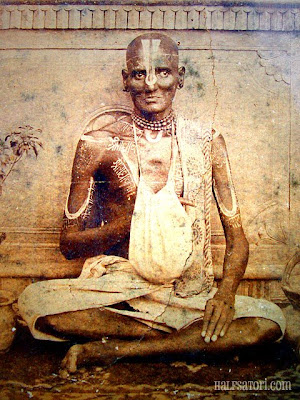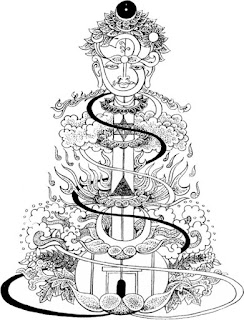Liberation through mantra
 |
| Vaishnava yogi performing Japa yoga. |
Have you been practising yoga for a long time and still feel like you haven’t realised the message of the yogic sages? If you’re looking for the experience of transcendence and dissolution of ego, which stands as the central stated purpose of all yoga texts, but haven't quite managed to get past those constant thoughts and distractions, It might be time to try mantra yoga
Mantra yoga has been described throughout almost every text in sanatana dharma, and it stands as one of the most accessible and practical tools for self-realisation that I’ve ever learned. Coupled with breath control and awareness of the pulsation rhythm of the body, mantras can take us directly into the state beyond thought and construct, to the essence of our being and the embodiment of the mantra itself.Mantra literally means “That which frees the mind” and it does this by replacing normal thoughts with a constructed thought pattern of transcendence so that the mind can become shaped or conditioned towards perceiving and experiencing that particular state.
Every mantra has a Devata or deity, ruler, or God/Goddess, and each devata represents the transcendent in a particular mood or with specific attributes and characteristics. Essentially, we are by meditation on their particular sound frequency, attaining nearness or likeness with that particular deity. By doing so, we involve that deity in our life, our consciousness, and are able to allow that deities influence to have a direct effect on the conscious/unconscious life events and perceptions. By fully immersing ourselves in the deity, we can actually attain the vision of reality according to that deities mandala or matrix.
 A mantra has a history and the history of every mantra traces itself back to the original rishi or sage who realised the mantra from his/her own consciousness directly. For example; the maha-mantra of the Vaishnava tradition was first realised and taught by the sage Narada, who is the most important Rishi for those on the path of Bhakti yoga. Narada is essentially the person who perfectly saw reality according to the mandala or matrix contained in that mantra. A spiritual matrix which is called Goloka Dhama, within which the eternal happenings of Sri Sri Radha and Krishna take place. Narada’s vision of reality, of life, and all this is, is actually the eternal love play of Radha and Krishna. So, those who are adept in chanting that particular mantra, under the guidance of Rsi Narada, will see realise themselves and attain that vision of life. That vision was taught again by Sri Krsna Chaitanya Mahaprabhu(18 February 1486 – 14 June 1534) and is being taught all over the world today by various branches of his lineage. The lineage which I also belong to.
A mantra has a history and the history of every mantra traces itself back to the original rishi or sage who realised the mantra from his/her own consciousness directly. For example; the maha-mantra of the Vaishnava tradition was first realised and taught by the sage Narada, who is the most important Rishi for those on the path of Bhakti yoga. Narada is essentially the person who perfectly saw reality according to the mandala or matrix contained in that mantra. A spiritual matrix which is called Goloka Dhama, within which the eternal happenings of Sri Sri Radha and Krishna take place. Narada’s vision of reality, of life, and all this is, is actually the eternal love play of Radha and Krishna. So, those who are adept in chanting that particular mantra, under the guidance of Rsi Narada, will see realise themselves and attain that vision of life. That vision was taught again by Sri Krsna Chaitanya Mahaprabhu(18 February 1486 – 14 June 1534) and is being taught all over the world today by various branches of his lineage. The lineage which I also belong to.
There are other details to mantras such as Chandah(rhythm or syllabic compositions), shakti(the particular energy of the deity) kilakam(the pin which locks the mantras potential from unworthy or dangerous use) and Bija(Seed form, the original basic principle the mantra is working with) and viniyoga(intention). All these details are usually listed in the particular tantra(text) the mantra is taught within. For the details of the maha-mantra one could consult the Gautamiya tantra or Sanat-kumara samhita.
 It’s is very important for the successful practice of mantra yoga, to receive the mantra from a legitimate Guru or Acharya to learn the details of pronunciation, dosage, panchanga(five parts of the mantra) and viniyoga in order to derive maximum benefit from mantra recitation. However, nama mantras like the maha-mantra do not require any particular rules or regulations, nor do they require initiation. This is why Sri Krsna Caitanya Mahaprabhu gave this mantra for Kali-yuga as it is very difficult to get genuine knowledge of all these finer details to practice mantra effectively. I highly recommend finding a solitary place, a nice tulsi rosary, and meditating deeply on the Maha-mantra. Read various commentaries on its meanings and history, and try to understand the full message contained within it. It is truly an amazing package of love from your very own true Self just waiting for you to turn your attention and look towards your own self-liberating deity.
It’s is very important for the successful practice of mantra yoga, to receive the mantra from a legitimate Guru or Acharya to learn the details of pronunciation, dosage, panchanga(five parts of the mantra) and viniyoga in order to derive maximum benefit from mantra recitation. However, nama mantras like the maha-mantra do not require any particular rules or regulations, nor do they require initiation. This is why Sri Krsna Caitanya Mahaprabhu gave this mantra for Kali-yuga as it is very difficult to get genuine knowledge of all these finer details to practice mantra effectively. I highly recommend finding a solitary place, a nice tulsi rosary, and meditating deeply on the Maha-mantra. Read various commentaries on its meanings and history, and try to understand the full message contained within it. It is truly an amazing package of love from your very own true Self just waiting for you to turn your attention and look towards your own self-liberating deity.
#Jainitai



Comments
Post a Comment